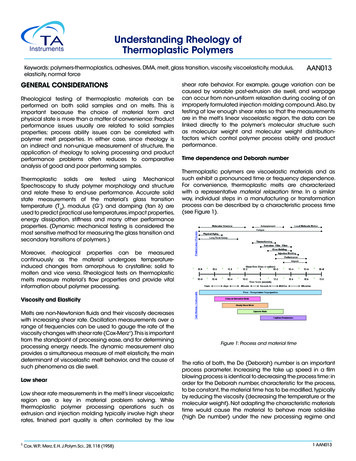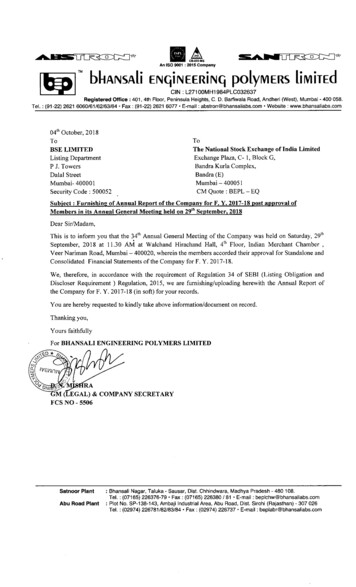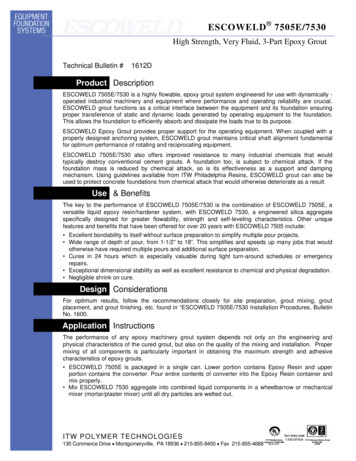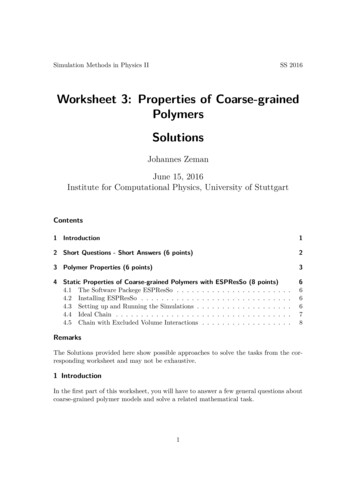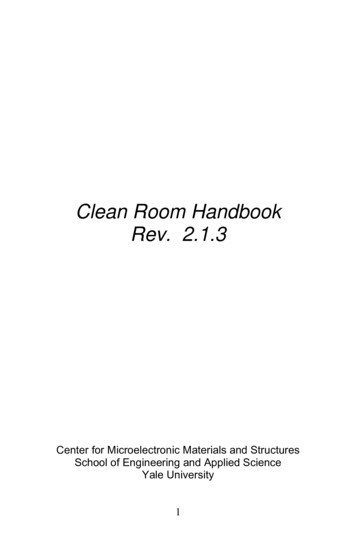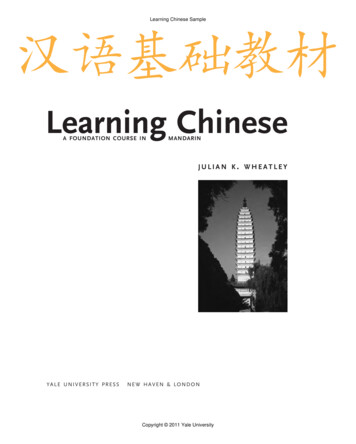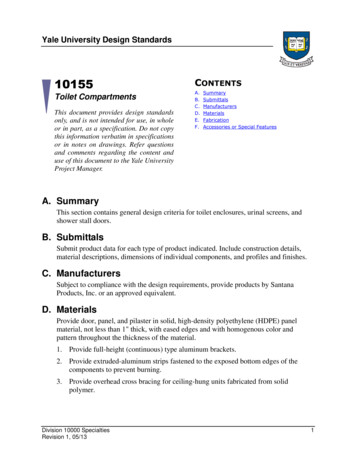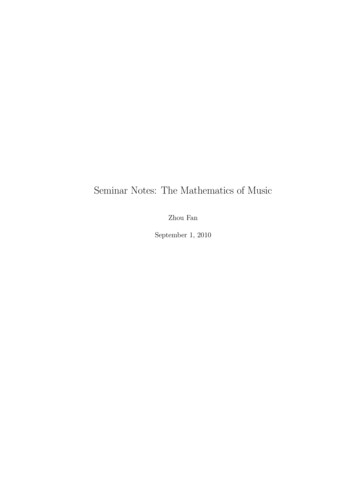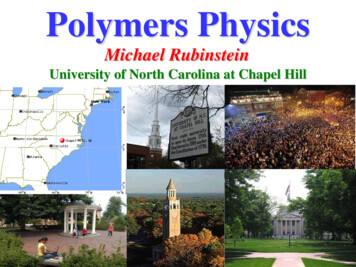
Transcription
Polymers PhysicsMichael RubinsteinUniversity of North Carolina at Chapel Hill
Outline1. “Real” Chains2. Thermodynamics of Mixtures3. Polymer Solutions
Summary of Ideal ChainsIdeal chains: no interactions between monomers separated by many bondsMean square end-to-end distance of ideal linear polymerR 2 Nb 22NbMean square radius of gyration of ideal linear polymer Rg2 6 3 3 / 2 3R 2 exp Probability distribution function P3d N , R 2 2 2 Nb 2 Nb 23RFree energy of an ideal chain F kT2 Nb 2 3kT REntropic Hooke’s Law f 2Nb3 1g(r) Pair correlation function rb2
Real ChainsInclude interactions between all monomersShort-range (in space) interactionsProbability of a monomer to be in contact with another monomerfor d-dimensional chaind N * b dRIf chains are ideal R bN 1/ 2 * N 1 d / 2small for d 2Number of contacts between pairs of monomers that are far alongthe chain, but close in spaceN * N 2 d / 2 small for d 4For d 4 there are many contacts between monomers in an ideal chain.Interactions between monomers change conformations of real chains.
Life of a Polymer is a Balanceof entropic and energetic parts of free energyEntropic part “wants”chains to have ideal-likeFentconformationsFengEnergetic part typically“wants” something else(e.g. fewer monomermonomer contactsin a good solvent).Chain has to find a compromise between these two desiresand optimize its shape and size.R
Flory TheoryNumber density of monomers in a chain is N/R3Probability of another monomer being within excludedvolume v of a given monomer is vN/R3Excluded volume interaction energy per monomer kTvN/R3Excluded volume interaction energy per chain kTvN2/R3Entropic part of the free energy is of order kTR2/(Nb2)Flory approximation of the total free energy of a real chain N 2 R2 F kT v 3 2 Nb RRFree energy is minimum at R v1/ 5b 2 / 5 N 3 / 5Universal relation R N - Flory scaling exponentMore accurate estimate 0.588
1000Rg (nm)1000. 5 91/21011 041 051 061 071 08Mw ( g/mole)Radius of gyration of polystyrene chains in a q-solvent (cyclohexaneat 34.5oC) and in a good solvent (benzene at 25oC).Fetters et al J. Phys. Chem. Ref. Data 23, 619 (1994)
Polymer Under TensionIdeal chainReal chainUnperturbed sizeRF bN 3 / 5R0 bN 1/ 2xTension blobs (Pincus blobs) of size xcontain g monomersRfChains are almost unperturbed on length scales up to x3/ 51/ 2x bgx bgOn larger length scales they are stretched arrays of Pincus blobsN Nb 2 R02Rf x gxxR02x RfN Nb5 / 3 RF5 / 3R f x 2/3 2/3gxxSize of Pincus blobsRF5 / 2x 3/ 2Rf
Polymer Under TensionIdeal chainx R02Real chainSize of Pincus blobsRF5 / 2x 3/ 2RfRfFree energy cost for stretching a chain is on order kT per blob2Rf RfN F kT kT kT gx RF Tension force is on order kT divided by blob size xRf RfNF kT kT kT gx R0kT 3 / 2 kT R f f 5/ 2 R f x RFRF RFkT kTkT R ff 2 Rf x R0R0 R0linear elasticityFor b 1nm at room TkT/b 4pN kTkT/bf013/2RfR0 RF Rmax5/ 2 3/ 2non-linear elasticityeven at low forcesLog – log plot
Polymer Under TensionReal chainIdeal chainf kTR R f20linear elasticitykT/bf1R0 RFf kT RF5 / 2 R 3f / 23/2Rfnon-linear elasticityRmaxChallenge Problem 1: Pulling a RingConsider a pair of forces applied to monomers 1 and 1 N/2i. Show that the modulus of an ideal ringis twice the modulus of a linear N/2-mer f f 2 f 2ii. How does modulus of a ring in a good solvent Grcompare to twice the modulus of linear N/2-mer GN/2?a. Gr 2GN/2 similar to ideal caseb. Gr 2GN/2 because the entropy of sections of a ring is lowerc. Gr 2GN/2 because ring sections reinforce each other f f 2 f 2
Biaxial CompressionIdeal chainR Real chainDR DOn length scales smaller than compression blob of size D chain is almost5/32unperturbedD D g g b b Occupied part of the tube1/ 22/3Nb N R D NbR D bN 1/ 2 g D g Free energy of confinement5/32Nb Nb Fconf kT kTN Fconf kT kTN g D g D R Fconf kT 0 D 2FconfRF kT D 5/3
Challenge Problem 2:Biaxial Confinement of a Semiflexible ChainConsider a semiflexible polymer – e.g. doublestranded DNA with Kuhn length b 100nm andcontour length L 16mm.Assume that excluded volume diameter of doublehelix is d 3nm (larger than its actual diameter2nm due to electrostatic repulsions).R DRFCalculate the size RF of this lambda phage DNA in dilute solutionand the length R occupied by this DNA in a cylindrical channelof diameter D (for d D RF).
Uniaxial CompressionFree energy of confinement in a slit is thesame as in the cylindrical poreDLongitudinal size of an ideal chain in a slit is the same as for anunperturbed ideal chain. R bN 1/ 2 2-dimensional Flory theory for real chain confined in a slitD2 is the excluded areaof a confinement blobwith g monomers2 2 ( N / g )2 R F kT D 22 R(N/g)D N R D Longitudinal size of a real chain in a slit g 3/ 4Fractal dimension of real chains in 2-d is D 4/31/ 4b bN 3 / 4 D
Scaling Model of Real ChainsThermal blob - length scale at which excluded 2gTvolume interactions are of order kTkT v 3 kTxT1/ 2Chain is ideal on length scales smaller than thermal blob xT bgTNumber of monomers in a thermal blob gT b6 v 2b4Size of a thermal blob xT vgood solvent v 0poor solvent v 0RxTRglxT N R xT gT 3/ 51/ 5 v b 3 b N3/ 5 NR xT gT1/ 3 b2v1/ 3N 1/ 3
Flory Theory of a Polymer in a Poor Solvent N 2 R2 In poor solvent v 0 and R 0F kT v 3 2 Nb RCost of ConfinementR g b Compression blob of size Rwith g monomersNNb 2Confinement free energy Fconf kT kT 2gR N 2 R 2 Nb 2 F kT v 3 2 2 For v 0NbR RR Nb 2Three Body Repulsion23 R 2 Nb 2Size of a globuleNNF kT 2 2 v 3 w 6 1/ 3 wN RRR Nb Rgl v 2R 0
Real Chains in Different SolventsxTathermalRRathermal bN 3 / 53/5xTRgood1gT3/ 5Rq bN 1/ 2good3/5 q-solvent1/2poor1/3xTnon-solvent1/3Rnon solvent bN 1/ 3b N xT gT N1/ 3R poor N xT gT
Temperature Dependence of Chain SizeMayer f-function{U r f r exp 1 kT Excluded volume -1for r b where U(r) kTU r for r b where U(r) kTkT4 q 3 2v 4 f r r dr 4 r dr U r r dr 1 b kT b T 002b2Interaction parameter z is related to number of thermal blobs per chainz Nv 1/ 2 T q 1/ 2 3N NgT bTChain contraction in a poor solventR 1 / 3 z1/ 2bNb6gT 2vChain swelling in a good solventR2 1 zbN 1/ 2
2.52.52.02.01.51.522Rg /Rq22Rg /RqUniversal Temperature Dependenceof Chain Size1.00.51.00.50.00.0-40 -30 -20 -100102030N (1 - q/T)1/2Monte-Carlo simulationsGraessley et.al., Macromolecules32, 3510, 1999 & I. Withers-505101520N1/2(1 - q/T)Polystyrene in decalinBerry, J. Chem. Phys.44, 4550, 1966
Summary for Real ChainsSize of Linear ChainsRq bN 1/ 2Rgoodnearly ideal in q-solvents v b 3 b 2 1 v N b 3 b Rathermal bN bN 0.588R poor v 1 / 3 2b N 1/ 30.18Excluded volumeT q v b3 T N 0.588 swollen in good solventsin athermal solventscollapsed into a globule in poor solventsIn good solventsStretching a real chain1 /(1 ) R R F kT kT RF RF non-Hookean elasticityConfinement of a real chain2.431 / RF kT F D 1.7R kT F D
Outline1. Real Chains2. Thermodynamics of Mixtures3. Polymer Solutions
Binary MixturesHomogeneous – if components are intermixed on a molecular scaleHeterogeneous – if there are distinct phasesAssume, for simplicity, no volume change on mixingConsider a mixture with total number n of monomers (sites)and total volume v0n where v0 – volume of a lattice siteAssume that a monomer of each species occupies the same volume v0 VAVolume fractionsVA A B 1 VA VB VBVA VB A n n monomers of type A and B nB (1- n monomers of type B
Entropy of Mixing - volume fraction of A nv0 1 nv0 1 - volume fraction of Bnv0v0 – volume of a lattice siteNumber of translational states of a moleculein a mixture is the number of sites n AB V A VB nv0VA A n v0Number of states of molecule A in a pure A phaseEntropy change upon mixing of a molecule A AB 1 k ln k ln S A k ln AB k ln A k ln A SnA/NA and nB/NB – number of A and B moleculesTotal entropy change upon mixing nA nAnBnB S S A S B k ln ln 1 NANBNB NA Infiniteslopes0 1
Energy of a Homogeneous MixtureMean Field TheoryAverage energy per A monomeruij – interaction of i with jA monomer with probability ?B monomer with probability 1 – ? A? ?zz – coordination numberu A u AA 1 u AB 2(number of neighbors)zAverage energy per B monomer u B u AB 1 u BB ?2Average energy per monomer in homogeneous mixtureUn u n uuf AABB u A 1 uB nz 22 u AA 2 1 u AB 1 uBB2 zu AA2umzuBB2 um1Average energy per monomer of pure components 0before mixing ui z u AA 1 uBB 2Energy of mixing um u f ui
Energy of Mixingu AA uBB U m num n 1 z u AB n 1 kT 2 Flory interaction parameter Umz u AA u BB u AB kT 2Probability of AB contact 1 Energy change on mixing per site01 um kT (1 )Free Energy of Mixing Fm U m T S mper site Fm1 kT ln ln 1 (1 ) nNB NA Regular solution: NA NB 1Polymer solution: NA N 1, NB 1Polymer blend: NA 1, NB 1
Flory-Huggins Free Energy of Mixing Fmix1 kT ln ln 1 1 nNB NA At lower T for 0 repulsiveinteractions are important andthere is a composition range ' ''with thermodynamically stablephase separated state.This composition range, calledmiscibility gap, is determined bythe common tangent line. Fmix/(kn)At high T entropy of mixing dominates, Fmix is convex and homogeneous0mixture is stable at all compositions. -0.1250o K-0.2-0.3300o K-0.4-0.5-0.6-0.7350o K0 ’ 0.20.40.60.8 ” 5o KNA 200 NB 100 T1
Phase Diagrams Fmix1 kT ln ln 1 1 nNB NA Critical composition cr NBN A NBFor a symmetric blend NA NB N cr 2/N cr 1/2For polymer solutions NA N, NB 111 11 cr cr N2N 2N0 N 2.7N FmixkTnthere is a miscibility gap for ' ' 'NA NB ’ sp1-0.1 sp243N cr2Two Phases10Single PhaseN For cr mixture is stable at allcompositions.2 1 11 Forcr 2 NANB 00.2 0.4 0.6 0.8 cr ”1
Phase Diagram of Polymer SolutionsPolymer solutions phase separate upon decreasingsolvent quality below q-temperatureB A TUpper critical solution temperature B 0binodalSolution phase separates belowthe binodal in poor solventregime into a dilute supernatantof isolated globules at andconcentrated sediment at .dilutesupernatantconcentratedsediment Single Phase spinodal ”unstable(spinodaldecomposition)metastableTwo Phases(nucleationand growth)M 53.3kg/molePolyisoprene in dioxaneTakano et al., Polym J. 17, 1123, 1985
Intermolecular InteractionsOsmotic pressure c 2P RT A2c . Mn A2 – second virial tyrene)in toluene at 25 oCNoda et al, Macromol.16, 668, 198130106 P/cRT (moles/g)solution2520Mn 70800 g/mole1510Mn 200000 g/mole500.00Mn 506000 g/mole0.01c (g/ml)0.02
Mixtures at Low Compositions Fmix1 kT ln ln 1 1 nNB NA Expand ln(1- ) in powers of composition 2 1 3 Fmix1 kT ln 2 . nNB 2 NB 6N B NA Osmotic pressure Fmix P Fmix V 2 3 n kT 1 3 3 2 . b b N A NB 2 3N B 2nA cn v 2 Virial expansion in powers3P kT c wc . nnof number density cn /b3 NA 2 1 3b6 2 bExcluded volume v 3-body interaction w 3N B NB vT q 2 A2 M 02 1 2 3In polymer solutions NB 13Tbb N Av
Polymer MeltsConsider a blend with a small concentration of NA chains in a meltof chemically identical NB chains.No energetic contribution to mixing 0. 1 3 b3is very small for NB 1Excluded volume v 2 b NB NB Flory Theorem6b2xT b gT bN Bg NThermal blobTB2vChains smaller than thermal blob NA NB2 are nearly ideal.In monodisperse NA NB and weakly polydispersemelts chains are almost ideal.RA3/52In strongly asymmetric blends NA NBbNAlong chains are swollen1/23/ 51 / 103/ 5 NA NA NA 1/2bR A xT bN B 2 bN A 2 2 N1NNN gT BA B B
Challenge Problem 3:RA2/(b2NA)Long NA-mer in a 3-d Melt of NB-mersNBNBNBNBNBNBNB1/ 5 NA R 2 2b N A NB 2ANA/NB2M. LangWhy doesn’t Flory Theorem work?
Challenge Problem 4:Mixing of Polymers with Asymmetric MonomersNA – monomersper A chainNB – monomersper B chainv0 – volume of a lattice site volume of a small B monomermv0 – volume of an A monomer m times larger than B monomerDerive the free energy of mixing Fmix of A and B polymers.Calculate the size RA of dilute Achains in a 2-d of B-chains form 1 in the case of 0.
Summary of Thermodynamics of MixturesFree energy of mixing consists of entropic and energetic parts.Entropic part per unit volume (translational entropy of mixing Smix ) T Smix1 kT ln ln 1 VvB vA Energetic part per unit volume U mix kT 1 Vv0vA – volume of A chainvB – volume of B chainv0 – volume of a lattice siteBFlory interaction parameter A TMany low molecular weight liquids are miscibleSome polymer – solvent pairs are miscibleVery few polymer blends are miscibleChains are almost ideal in polymer melts as long as they areshorter than square of the average degree of polymeriztion NA N2
Outline1. Real Chains2. Thermodynamics of Mixtures3. Polymer Solutions
Quiz #1Which of These Chains are Ideal?A. Polymer in a solution of its monomersB. Polymer dissolved in a melt of identical chainsC. Chain in a sediment of a polymer solutionin a poor solventD. None of the abovesediment
Polymer SolutionsTvTheta
Life of a Polymer is a Balance of entropic and energetic parts of free energy F ent F eng Entropic part “wants” chains to have ideal-like conformations Energetic part typically “wants” something else (e.g. fewer monomer- monomer contacts in a good solvent). Chain has to File Size: 1MBPage Count: 58

